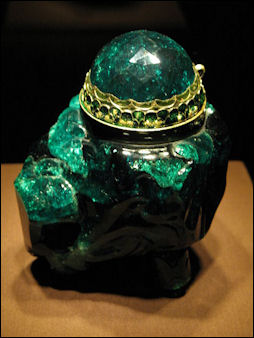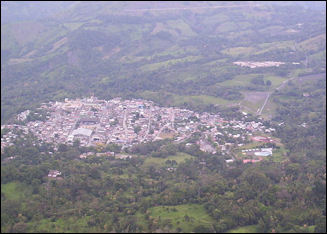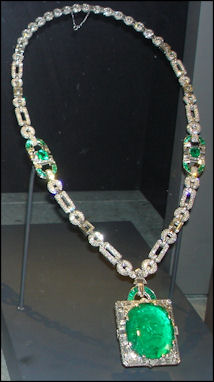EMERALDS
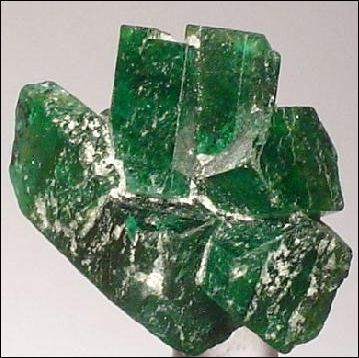
Emerald Beryl Emeralds are regarded as the second most valuable gemstone: more valuable than diamonds, and second only to rubies. To get a sense of just how valuable they are: a 14-carat million dollar emerald could be easily swallowed. That much money in one dollar bills would weigh over a ton. [Source: Fred Ward, National Geographic, July 1990, ╩]
Emeralds are beryls (minerals composed of beryllium aluminum silicate). In the 19th century mineralogists defined emeralds as berly colored by chromium (less than one percent) and green enough to be valuable. This definition endured until 1963 when a deposit of rich green colored beryls colored by vanadium was and they were accepted after much debate as emeralds.
The issue about what is a emerald is not settled and is a bit confusing. Richard Liddicoat, chairman of the Gemological Institute of America told National Geographic, "We say if a beryl has emerald color, its an emerald." But what about green beryls colored by iron? "Green beryls," he says, "should really not be called emeralds even though they're deep enough to be emeralds. A berly tinged by blue in greenish blue by iron is generally regarded as an aquamarine. To make matters worse, emeralds are usually oiled, to obscure cracks
Websites and Resources on Gems: All About Gemstones allaboutgemstones.com ; Minerals and Gemstone Kingdom minerals.net ; International Gem Society gemsociety.org ; Wikipedia article Wikipedia ; Gemstones Guide gemstones-guide.com ; Gemological Institute of America gia.edu ; Mineralogy Database webmineral.com ;
Gems and Birthstones
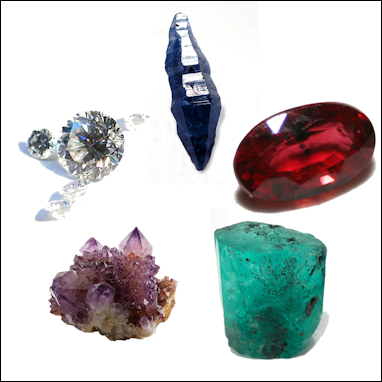
Cardinal gems Most gems are crystals formed by the cooling of hot gases, solutions and melts deep inside the earth. When excited atoms lose energy from cooling they form a lattice, typical of crystals. The natural laws that create gems are the same as those that create snowflakes and salt, except that tremendous pressures and temperatures are needed. Diamonds can only form at depths of 100 miles or more below the earth's surface where pressures are a million pounds per square inch and temperatures are above 2,500̊F.╿
Gems are classified as precious, semiprecious and ornamental stones. The size and weight of many gem is measured in carats. Carat is an ancient term which denotes the uniform weight of a carob seed — 1/142 of an ounce, 1/5 of a gram, or 200 milligrams. The value of a gem is often determined more by the quality of the stone and lack of imperfections than by size. Cut is term that describes the quality as well as shape of a gem. A loupe is a one-eyed lenses used by jewelers to examines gems closely.
Ancient man wore different kinds of stones as ornaments and jewelry. There is evidence of trade of exotic stones in Europe as far back as 28,000 B.C. Historical record from India in 300 B.C. describe the mining of moonstones, sapphires, diamonds, emeralds, garnets and agates.
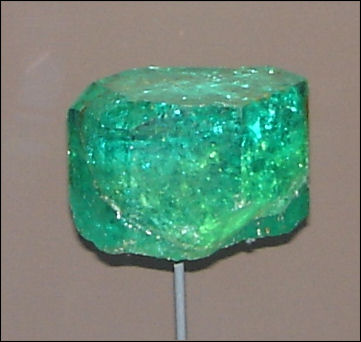
These days all gems are tampered with to some degree. Rubies and sapphires are heated to change their color. A clear topaz can be transformed into a blue one with a dose of radiation. And internal debris is removed from within diamonds with minuscule laser holes. It often very difficult for ordinary people to tell real gems from doctored ones from outright fakes. Glass and man-made zirconia are both passed of as rubies and sapphires.
Birthstones: 1) January: Garnet; 2) February: Amethyst; 3) March: Aquamarine; 4) April: Diamond; 5) May: Emerald; 6) June: Pearl of Alexandrine; 7) July: Ruby; 8) August: Peridot; 9) September: Sapphire; 10) October: Opal or Tourmaline; 11) November: Topaz; 12) December: Turquoise of Zircon.
History of Emeralds
Emeralds have been known for 5500 years. The earliest stones were mined from the legendary Cleopatra's Mines in the Sikait-Zabara region of Egypt. Until the Europeans discovered the New World it was the only source of emeralds. The ancient Egyptians, Greeks and Romans all worked these mines.
Unlike diamonds or rubies, emeralds were mentioned in the Bible: the forth foundation of the pearly gates was encrusted with emeralds and one of the twelve stones on breastplate of judgement was an emerald. The Koran describes paradise as being filled pearls and emeralds. Many of the most valuable treasures from the Ottoman and Persian Empires contained large emeralds.
Some of the grandest emeralds were possessed by the Turkish Ottoman sultans. Emerald treasures that can be seen today in Istanbul at Topkapi Palace — the home of the Ottoman sultans — include an emerald-plated snuff box and a gold writing box with emeralds and rubies. The 18th century emerald-studded dagger — featured in the Orson Wells film Topkapi “has three golf-ball size emeralds and rows of diamonds on the handle. A forth large emerald conceals a small clock. The dagger was originally meant to be a present for the Nadir Shah of Iran. He was assassinated before the gift could be presented so the sultan kept it.
The emerald pocket watch was also supposed to be a gift from the Turkish sultan to the ruler of Persia, but the messenger died before he got there and somehow the watch made its way back to Istanbul. Most of magnificent emeralds came from Colombian mines via Spain and India in the 17th and 18th century. "Diamond loving Europeans were at first not very found of emeralds," says gemologist Fred Ward, " which is one reason why the Ottomans...ended up with so many monstrous stones." The plot of Orson Wells film which stared Peter Ustinov and Maximilian Schell, revolved around the theft of the emerald dagger in the treasury.
The emeralds found in Mayan, Incan and Aztec treasures most likely came from Colombia, since there are no other deposits in the Americas. In the 1500's Spanish conquistadors found emeralds in Mexico and traced their source to Colombia. After looting more than 7,000 emeralds from Indians they found what they were looking for the famous Muzo emerald mine.
Many of the great emeralds found in Persia and Ottoman Turkey where said to come from an "Old Mine" in India. But it turns out that most them actually originated in Colombia, and were only cut and polished in India.╩
Emerald Mining and Processing
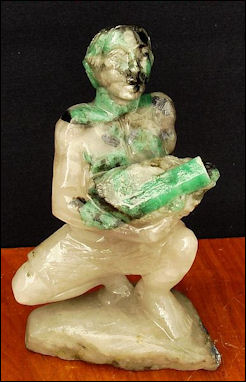
Emerald Miner carrying an
Emerald Crystal Perhaps a billion dollars of emeralds are mined each years. Half of them come from Colombia. Zambia accounts for 20 percent of the market and Brazil 15 percent. The next largest producers are Zimbabwe and Pakistan, with smaller amounts from Russia, Afghanistan, Australia, Madagascar, and Tanzania. Many of the emeralds are traded in Switzerland.
It is often hard to gage the quality of an emerald from the outside. In Colombia cutters cut away 60 percent of the raw stone in hopes of finding a gem worth $1 million or more but that only happens 3 percent of the time. Once four investors invested $50,000 each in a 700-carat stone obscured by rock on three side. The investors had hoped the stone would yield a gem worth $20 million but when the diamond saw cut into the emerald a cloudy center was revealed and the polished gem sold at an auction for only $10,000.
Summing up the mining of emeralds Ward said that "most people who find the stones cannot even imagine accumulating enough money to wear one."
After being cleaned with boiling acids emeralds are emerged in cedar oil and then placed into a pressure chamber to drive he oil deeper into the cracks. Almost every gem manufacturer does it and the only thing that is considered to be unethical is the use of green oil. The down side for customers is that oil dissipates after a few months or a year — even less if the gem is exposed to the sun.
Emerald Quality
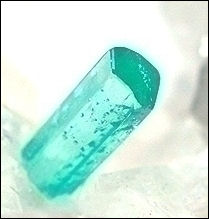
Emeralds are relatively soft. Their value is determined by clarity, sparkle and depth of color. Emeralds are often cloudy and full of cracks. High quality stones are very rare.
Emeralds, rubies and sapphires are often "enhanced" with heat, lasers and fillers like the oil mentioned above. Smooth, clean-looking stones often have fillings in the cracks..
Buyers should beware. Often glass, garnets, tourmaline, and man-made crystals are passed off as emeralds. Even professionals are fooled. Famous museums sometimes display green glass, chalcedony and fluorite under the emerald label.
The emerald business attracts adventurers and risktakers. Most of the gems are traded off the record, untaxed and unseen in a world market know as the black. According to Ward, "Almost every high quality gem is smuggled at some time in history."
Emerald Records
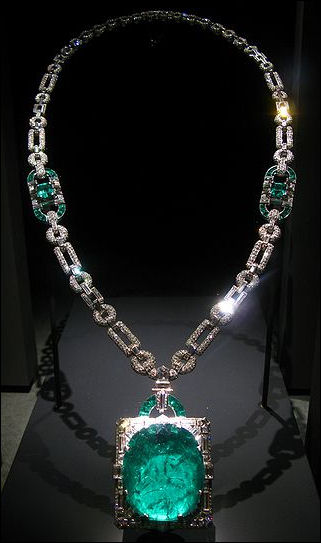
MacKay Cartier Emerald According to the Guinness Book of Records, the largest cut emerald (86,136 carats of natural beryl) was found in Carnaiba, Brazil in August 1974 and was carved by Richard Chan in Hong Kong. In 1982, it was valued at $1,120,080.
According to the Guinness Book of Records, the largest single emerald crystal (7,025 carats) was found in Cruces Mine near Gachala, Colombia in 1969.
According to the Guinness Book of Records, the highest price paid for a single emerald was $2,126,646 for a 19.77 carat emerald and diamond ring made by Cartier in 1958 and sold by Sotheby's in Geneva in April 1987.
Their prices have dropped in recent years from a peak of $11,000 a carat in 1996 to $6,000 a carat in 2000.
Emeralds in Colombia
Colombia produces about 60 percent of the world's emeralds. Most of them come from the mines in Muzo, Coscuez, Chivor and Somondoco in the remote shale mountains north of Bogatá in the province of Boyaca. As of the 1990s the emeralds produced by Colombia were worth over half a billion dollars and over 60 percent of them were exported illegally. [Source: Fred Ward, National Geographic, July 1990]
In 1988 Colombian government figures showed just $11.5 million of emerald exports to the Unites States. During the same time period $42 million was declared at U.S. customs in Miami alone. But perhaps another $200 million in emeralds arrived unannounced. To get an idea of the scale of smuggling that goes on, in 1989 the government sponsored two sales at the Coscuez mine, netted only US$750,000, while the production at the mine as a whole was estimated to be $180 million.
A glorious, fist-size 1,759-carat emerald from the Coscuez mine was thought to be to be too magnificent to cut. It and five other humongous emeralds were kept in cigar boxes in safety deposit boxes in the national bank in Bogatá before being placed in sumptuous bank vaults.
Muzo Emerald Mine in Colombia
Muzo Muzo is by far the largest and lucrative emerald mine in the world. For a thousand years it has produced the biggest and best quality emeralds ever found, including fist-size stones sold by Chibcha Indians to Spanish conquistadores. Now, however, the veins at Muzo are largely played out and the mine produces many less quality stones than it once did. So much shale has been scraped off the mountain that the floor of the valley has been raised 100 feet in 50 years by emerald-bearing shale tailings. ╩
Muzo looks like a huge open pit coal mine. Black powdery shale covers every one and everything. Colombians maintain that the emeralds belong to any Colombian who can mine them. Hence a riotous anything goes atmosphere prevails. Some large companies hold leases but the bulk of the work is done by thousands of armed treasure hunters called guaqueros . Most of the mining is done on the surface with bulldozers that scrape away shale and uncover the most obvious stones, but leave the majority behind. Using long hoses tapped into nearby steams the guaqueros go through the tailings left behind like sharks in a feeding frenzy grabbing at any stones they can find. ╩
The emeralds at Muzo," according to Ward," are found in hydrothermal veins of calcite buried with black shale. In order to foster employee honesty and enthusiasm [the largest mining company] practice a unique social program with its 250 workers — a system pick-ups, in which each man is rewarded with one day a month at the face, the area actively being mined. As a dozer blades exposes mineral crystals, the whole crew races to the wall in a mad scramble to grab gemstones. After the free-for-all the representative, usually a member of one of the three families that control Muzo, keeps the biggest and best for the owners , leaving the rest as a goodwill bonus for the workers. ╩
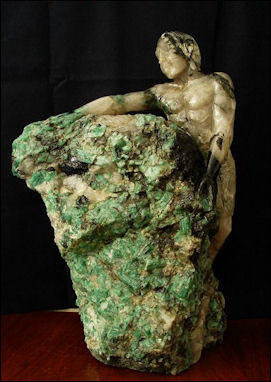
Emerald miner
Coscuez Emerald Mine in Colombia
Colombia other large emerald mine is located near the town of Coscuez. It consist of several "fronts," each of which has 50 or 60 shafts that lead into an emerald-rich mountain. Since Muzo has become played out, Coscues has become the largest emerald producers but the stones are low quality blue-greens like those found in Brazil and Africa. [Source: Juanita Darling, Los Angeles Times, January 17, 1998]
Describing the inside of Coscuez mine, Juanita Darling wrote in Los Angeles Times, "Explosions shake the narrow tunnels dug a mile into the mountain. Huddled together, the miners calmly count them off. When they reach sum — the number of charges set — a dozen men and women scramble into the dynamited hole. Eyes filled with desperation search the cave walls for a speck of green. Eager hands sift through the ruble hoping to pick out a crystal."
To boost productivity the emerald families have hired geologists and engineers to run the mines and search for new emerald sources. A Canadian mining firm introduced new technology, management techniques and even normal wages. Even though the company has filled Coscues mountain with truck size hole, it has yet to find enough emeralds to cover its costs.
Esmeralderos
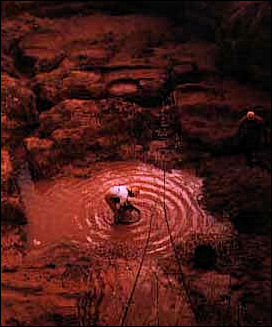 Esmeralderos , the people who work the emerald mines, live by a special code of honor and do not take kindly to outsiders. About a dozen Boyaca families control the 300,000 or so people who work in the emerald trade. To maintain control of their lucrative business the Boyaca families have had to fight off drug dealers, leftist guerillas and the government.
Esmeralderos , the people who work the emerald mines, live by a special code of honor and do not take kindly to outsiders. About a dozen Boyaca families control the 300,000 or so people who work in the emerald trade. To maintain control of their lucrative business the Boyaca families have had to fight off drug dealers, leftist guerillas and the government.
"Esmeralderos," wrote Darling "are devoted to the Virgin of Carmen, a vison of Mary, with being religiously devout; bosses demand absolute loyalty but tolerate petty theft. Women are respected as engineers, traders and even miners but, after working hours...'a wife of 24 and various mistresses of 14'...Men and women alike wear emeralds’set in gold chains in rings that stretch to their first knuckle or on the hands of watches.
"To break one's word us the most sever offense and is punished by death, anthropologist and emerald culture expert Maria Victoria Uribe told the Los Angeles Times. "Knowing what group [a person] belongs to and where his loyalties lie is fundamental. That is why the local community must vouch for an outsider."
Miners make money from their share in emerald production and with stones that they smuggle out. The Esmeraldero lifestyle was immortalized in Colombia in the telenovela GreenFire , which portrayed the emerald mines as a Latin American Wild West.
Guaquera
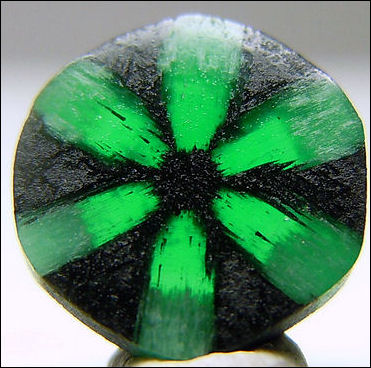
Trapiche emerald Miners are given food and a place to sleep. Below the miners are guanqueros , the lowest rung in the emerald trade. They sift through mine shaft debris for stones.
One female guaquera who worked for five years in Muzo and then found a stone that she sold for $2,500, told the Los Angeles Times, "I had never had so much money. I was surprised. I was excited. I put the money to work buying [gems]. Everything began because of that stone." She is now a successful germ dealer and president of a association that represents 5,000 gem cutters.
Emerald Violence
Muzo is sometimes called the most dangerous place on earth. Almost everyone there has a gun stuck in their belt. Murders average one or two a day, an the rate was even higher before beer and wine sales were banned. Ward had made plans to visit one the mine’s three most powerful owners but a week before he was to arrive the trader and his 17 bodyguards were all gunned down. Within two years after Ward wrote the article about the emerald trade in Colombia, half the people he interviewed were dead. ╩
Visitors insane enough to travel to the mine are advised to fly in by helicopter rather than drive. Bandits hide out on the roads, robbing incoming travelers of cash and outgoing ones of emeralds. Even large convoys of 50 vehicles are attacked, and dozens of deaths have been reported. ╩
An emerald war between esmeralderos and the Boyaca families that lasted for six years and ended in 1990 left 3,500 people dead and ended with the emerald lord Victor Carranza as the most powerful man in the emerald business. Carranza, a short man with legendary luck, had success earlier driving drug traffickers and guerrillas out of the emerald trade by creating an alliance with a powerful drug lord and hiring death squads to hand the guerilla problem.
In Muzo, violence left 40 percent of all households headed by women.
Emerald Business
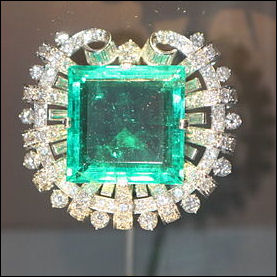
Hooker emerald The center of emerald trading business in Bogata is Jimenez Street. Most of the stones sold here were found by guaqueros. The remainder are smuggled out by miners.
In Bogota owners sell emeralds in white envelopes to drug dealers known as comisionistas who then seek buyers waiting in nearby buildings. Describing how business works there and American emerald dealer said "An agent might ask US$100 for a stone, I might counter with US$50." ╩
The pockets of the comisionistas are full of cash and plastic containers with emeralds worth $1,000 or more a carat.
Top quality gems are sold at auctions organized by the mining companies. At the Coscuez mine, the auction takes place in the mining company's two-story concrete headquarters, where men in cowboy hats arrive by helicopter with briefcases full of cash and make bids on lots of emeralds classified by quality.
The price of emeralds went up in the early 1990s when gem dealers bought up emeralds out of fear of a glut in the diamond market brought about by an infusion of diamonds from he former Soviet Union. When the diamond market stabilized the price of emeralds went down.
Emeralds in Brazil
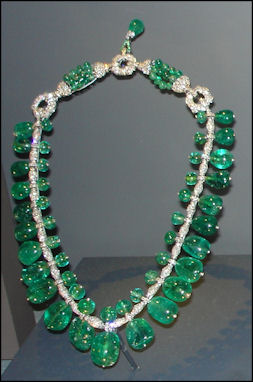
Brazil is a producer of lesser quality emeralds. Emeralds mines in the Santa Teresinha region of Brazil are reached by 300 feet deep shafts, only a yard in diameter. The miners are lowered to the bottom in an automobile tire bolted to a steel cable by a winch. The shafts are unsupported and near the bottom groundwater leaks through the walls in waterfall proportions. Geologist Fred Ward described the shaft as the blackest hole he'd ever seen and the journey down and as the most hair-raising ride in his life. [Source: Fred Ward, National Geographic July 1990 ╩]
"Miners, stripped to their shorts cope with heat and humidify," Ward wrote in National Geographic, "were using picks and an air hammer to dig out the ore. Gemstones actually protruded from the walls of the mine as in the treasure cave of the Seven Dwarfs, sparking green is talc schists, where an ideal combination of elements, heat a and pressure initiated the growth of the precious crystals.” ╩
"A Brazilian can get a garimpeiro (prospector) card and stake a small mining claim, usually 30 feet square, in any free area. Successful claims later sell among garimpeiros for US$20,000 and up. At Santa Teresinha in the 1990s more than 15,000 people live around 200 shafts from 60 to 400 feet deep, each sunk in a tiny plot, and each in danger of running into a neighbor's claim or collapsing it with underground dynamite. ╩
Brazil probably mines five times as many carats as Colombia, but Brazil's emeralds are smaller and lower quality. Together the two countries produce as much as 70 percent of the worlds' supply of emeralds, but Colombia's are sold for perhaps $500 million while Brazil's whole lot sells for only a fifth as much. ╩
Most of the emeralds are sold in the town Santa Teresinha. "Lawlessness and guns are unusual here," said a Dutch dealer, When we strike a deal, unlike in Colombia we buyers take the goods, then have a week to pay. It probably keeps us from being robbed or killed to have possession of the goods here in a vault or safely in Rio and still owe the sellers." ╩
Zambia hold about 20 percent of the world's emerald and all the ones that government gets a hold of are cut and polished by Brazilian craftsman. ╩
Emeralds in Zambia
Some twenty percent of the world's emeralds come from Zambia and about half are smuggled out of the country by the black market, despite the government's best efforts to stem the illegal trade. "Emeralds" by Fred Ward, July 1990 [╩];
Kagem is the Zambia's largest emerald mine. To help you appreciate how the grassroots smuggling works. The more workers the mine hires the more production declines. On the other side of the river from the mine independent miners move tons of earth in their quest for gems. When they are asked how they are doing "No emeralds yet" is the usual reply. Workers at Kagem mine who sort and remove debris from the stones are watched over guards. Often there is at least one guard watching over every man working. ╩
Most of the emerald middlemen in Zambia are West Africans, usually Senegalese. They offer the going world prices and pay in hard currency on the spot. By contrast the government pays its suppliers with worthless Zambian currency at prices set by the government. After suppliers turn in the emeralds they have to wait to get payed. ╩
Before 1988 Israel had an exclusive relationship with the Zambian government to cut all their emeralds. But that agreement essentially became null and void when the Zambian president banned all rough cut exports. After that Israel had to scramble for stones like everyone else. Their factories are built to handle a large capacity and they were in trouble without a steady supply of emeralds from Zambia. As for dealing with the Senegalese smugglers one factory owner said, “It's a bit difficult for Israelis to develop a solid business relationship with devoutly religious Muslim West Africans.” ╩
The smugglers used walk across the border to the Democratic Republic of Congo (Zaire), where they consolidated parcels and one or two smugglers flew to Switzerland to sell the rough gems. The legal stones ended up in Zambian cutting factories operated by Brazilians. The finished stone from these factories are also sent to Switzerland. ╩
Synthetic Emeralds
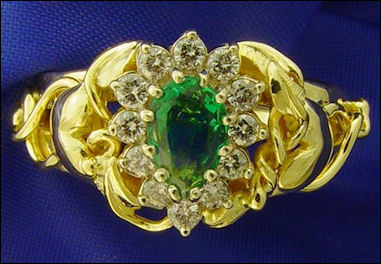
Emeralds, rubies and sapphires can all be produced in the laboratory. Sometimes the synthetic versions like more authentic and have fewer flaws than the stones mined from the ground.
The first synthetic emeralds were produced in 1935. They have the same chemical composition of natural stones and cost $200 a carat instead of $2000 a carat. To make them lithium molybdate is heated to 1800̊F inside a washing machine-size crucible. Beryllium oxide, aluminum oxide, silica and chromium are added in the same proportions as those found in nature. A seed crystal is added and if all goes well an emerald grows within a year.
It is not all that difficult to make artificial emeralds that are difficult to distinguish from mined ones. The Stauerff Co. runs advertisements in magazines offering virtually flawless artificially-made 2.5-carat emerald rings for $200 and necklaces made with rough stones for $100. The ad says that a flawless mined emeralds of the same quality would cost thousands of dollars.
Image Sources: Wikimedia Commons
Text Sources: Mostly National Geographic articles. Also the New York Times, Washington Post, Los Angeles Times, Wikipedia, The Independent, Times of London, The New Yorker, Time, Newsweek, Reuters, AP, AFP, Lonely Planet Guides, Compton’s Encyclopedia and various books and other publications.
Last updated March 2011

